EXCLUSIVE: Gucci Cosmos’ Circular Worlds Ignite Shanghai
- Oops!Something went wrong.Please try again later.
- Oops!Something went wrong.Please try again later.
- Oops!Something went wrong.Please try again later.
- Oops!Something went wrong.Please try again later.

SHANGHAI — To showcase Gucci‘s 102 years of heritage and era-defining classics, the Kering-owned luxury brand installed an immersive exhibition at Shanghai‘s West Bund, a former aircraft factory overlooking the Huangpu River.
Opening Friday, the itinerant exhibition comes at a critical time for the Florentine house, as the brand began to introduce a more timeless approach since the end of last year to restore its luxury appeal.
More from WWD
This September, new creative director Sabato De Sarno will open up the next chapter for Gucci, succeeding Alessandro Michele, who suddenly left the company last November.
“When we opened the Gucci archive in Florence in July 2021 to celebrate our centennial, we immediately decided China would be the first global destination to bring this historic exhibit about the house and its heritage to life,” said Marco Bizzarri, president and chief executive officer of Gucci.
Walking through the exhibition on Tuesday, Bizzarri said he noticed that the essence of the brand story lies in the designers and artisans behind the work, thus “Gucci Cosmos is really a tribute to them.”
To cast a fresh eye on its most iconic pieces, Gucci enlisted Italian fashion theorist and critic Maria Luisa Frisa as curator of the show. Es Devlin, the renowned British artist who created the monolithic ring for Saint Laurent’s spring 2023 men’s collection in the Moroccan desert, was in charge of devising a series of imaginative sets, larger-than-life sculptures and multimedia artworks for the exhibition.
Frisa spent six months looking for the most noteworthy pieces from the Gucci archive, weaving together the house’s founding history, its equestrian connection, its most iconic bags, and archival looks from the Tom Ford, Frida Giannini and Alessandro Michele eras.
The exhibition is organized into eight themes, or “worlds,” that offer a comprehensive view of the brand’s history and creativity. It will be open to the public from Friday to June 25 before embarking on a global tour.
“The strength of this exhibition is that this is an immersive experience. So the visitors that enter this world can feel the strength of the dialogue between the objects, the dialogue between the object and the display,” Frisa said in an exclusive interview.
“Part of the show’s challenge was to let the audience understand the importance of each object, item, garment, or accessory. We often take for granted items like the Bamboo bag, but in the 1940s, when it was first invented, there was a lot of research behind how to bend the bamboo on the flame into a handle,” Frisa explained. “It was a novelty for the time; it is still an important part of Gucci’s craftsmanship and expertise.”
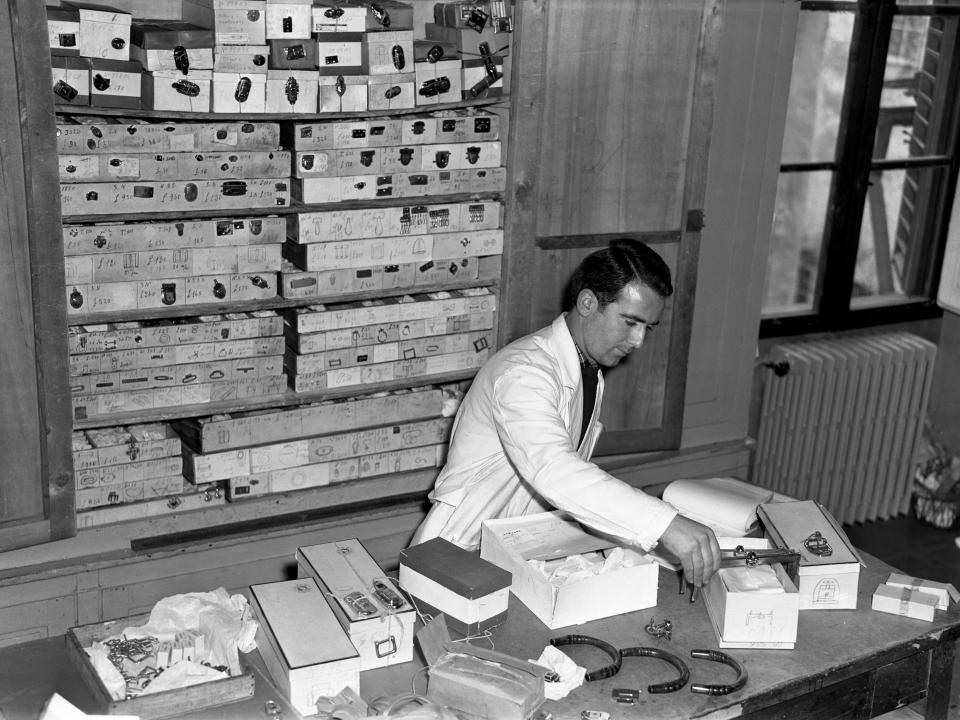
The exhibition’s opening section, which features revolving doors modeled after The Savoy Hotel in London, tells the story of its founder Guccio Gucci’s time working as a porter at the London hotel. Named “Portals,” the section presents the brand’s luggage design, some of which were highlighted in a recent campaign called Gucci Valigeria fronted by Ryan Gosling.
Eight multimedia dioramas, which pay homage to the house’s cultural icons such as Jacqueline Kennedy Onassis; Diana, Princess of Wales; Princess Grace of Monaco, and its global brand ambassadors including Chris Lee, Ni Ni, Lu Han, and Xiao Zhan, insert a playful dialogue to the section.
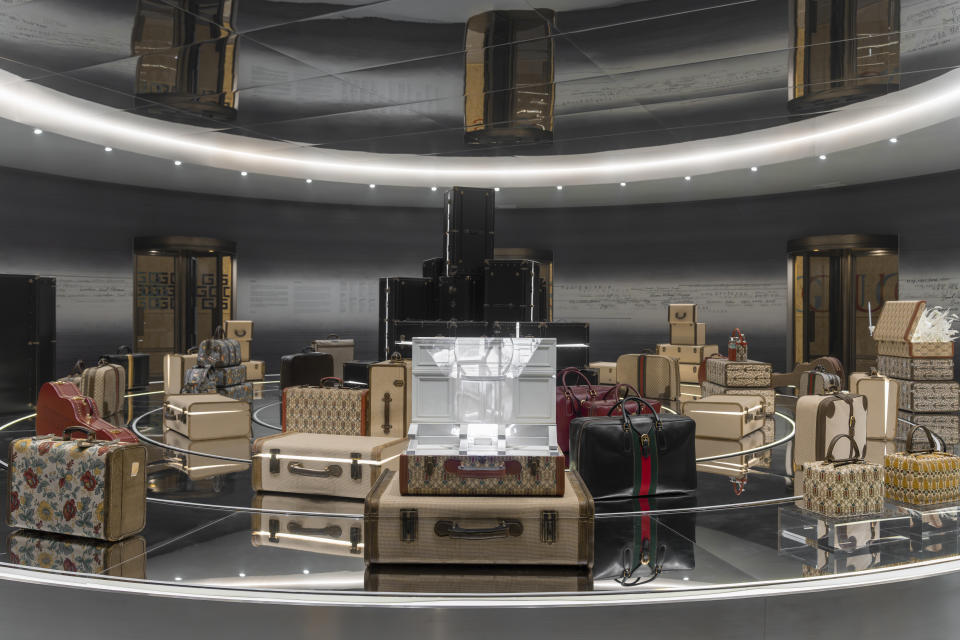
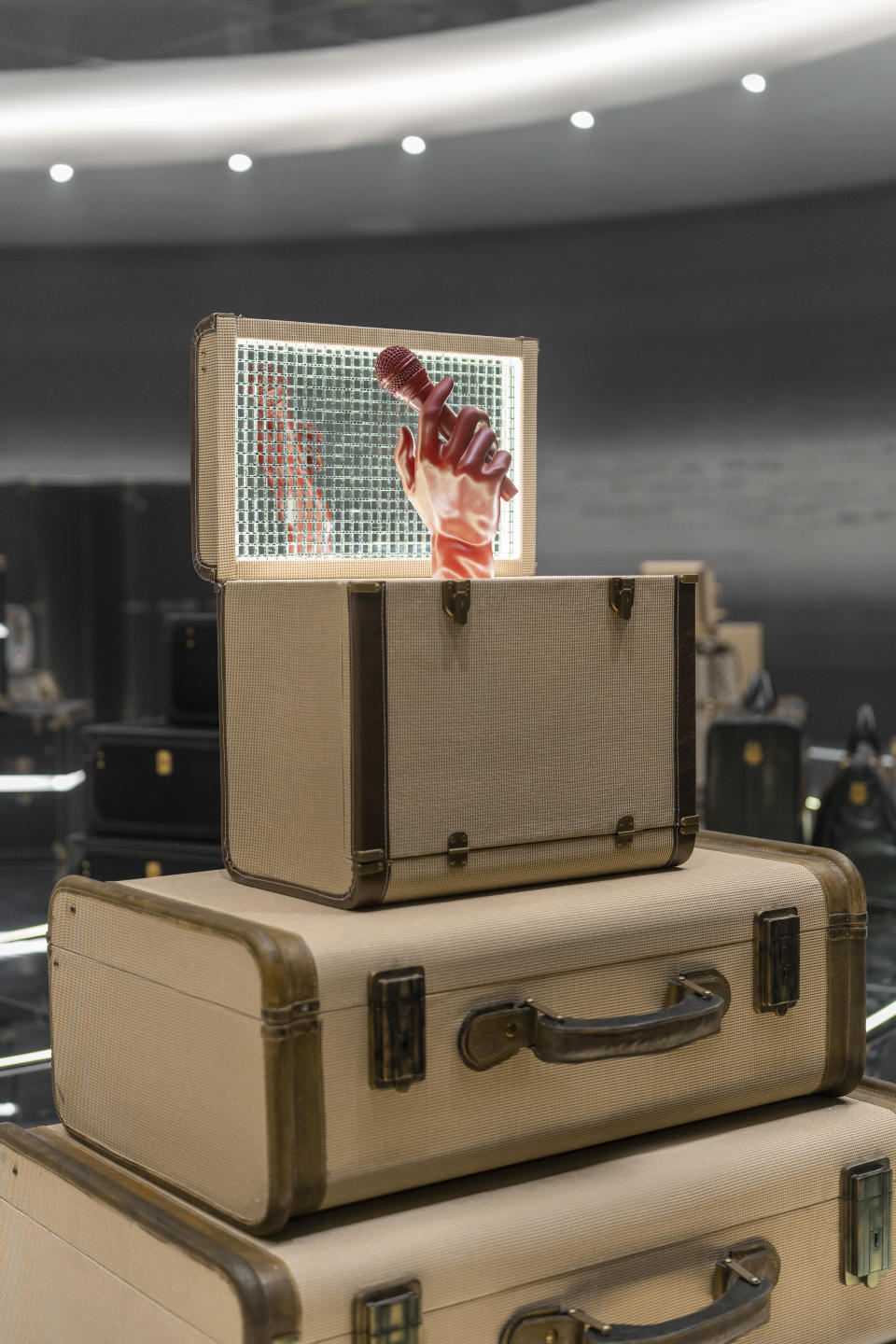
Exiting the “Portals,” one is offered a choice to enter two circular spaces titled “Eden” and “Zoetrope,” which highlight the house’s signature floral motifs and equestrian roots, respectively.
Inside “Eden,” flowers, insects and plants found in silk scarf designs created by Italian artist and illustrator Vittorio Accornero de Testacomes in the ‘60s, spring to life in the form of paper-cut-like ornaments. Floral garments, handbags and scarfs fill the space with a heightened sense of wonder.
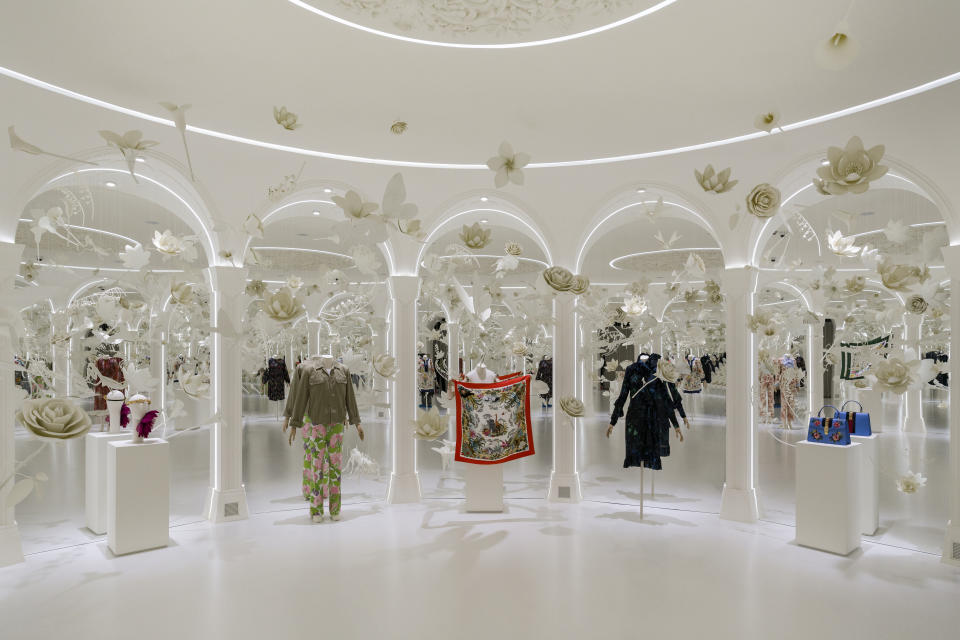
While many are familiar with the floral scarf created for Princess Grace of Monaco, Frisa pointed to an archival Jackie bag as a more dynamic variation within Gucci’s floral world. Designed by Tom Ford in the ‘90s, the floral Jackie is “not only a new interpretation of the Jackie bag, but also a reinterpretation of the floral motif,” said Frisa.
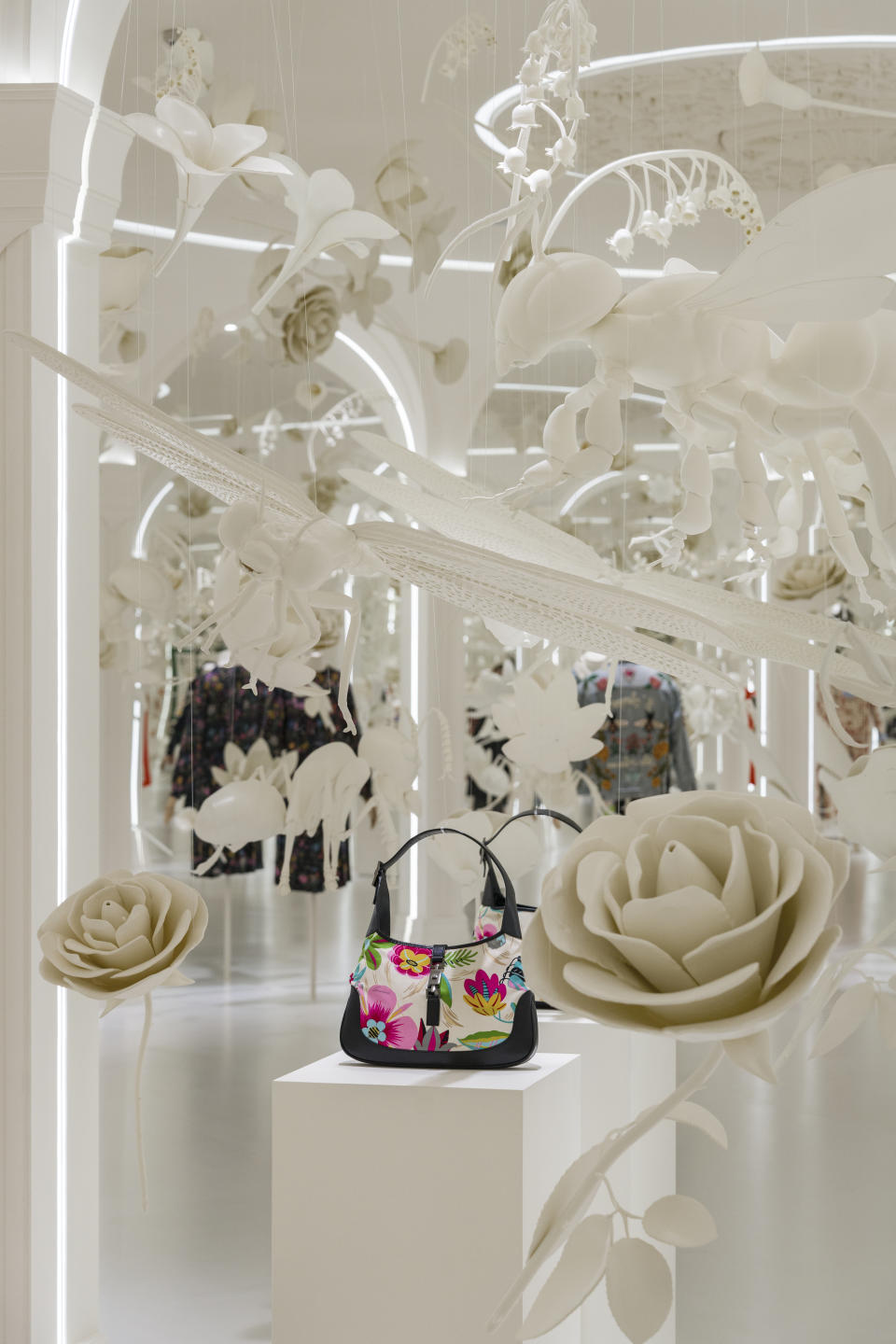
At “Zoetrope,” the brand’s iconic Horsebit motif, which was created in the ‘50s, is put on full display as it adds a touch of elegance, sportiness and even sex appeal to everyday garments. Every other minute, the room goes dark as virtual galloping horses take over the circular ring, with horse-riding-inspired words playing as background beats.
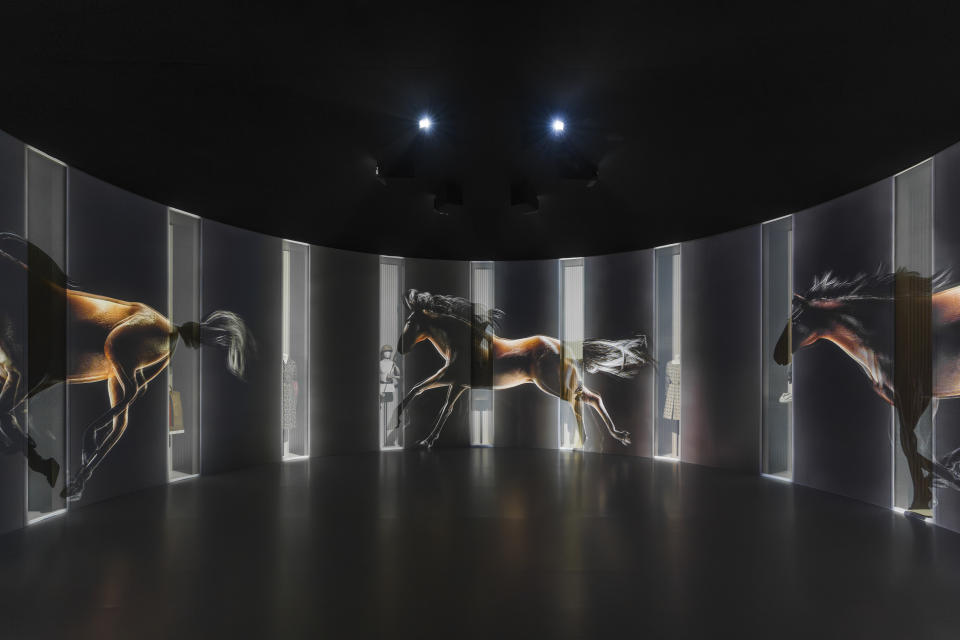
For Frisa, “Zoetrope” is one of the most interesting rooms because it interrogates humankind’s relationship with animals.
“It is a very contemporary question to explore man’s relationship with the horse, and with other animals,” observed Frisa. “It also gets you thinking about how the uniform of the equestrian suit, which is the same for both men and women, is at the roots of the Gucci brand.”
Next, visitors are greeted by two larger-than-life 10-meter-tall illuminated statues that could’ve been modeled after Alessandro Michele or Jared Leto, the ultimate fashion twins.
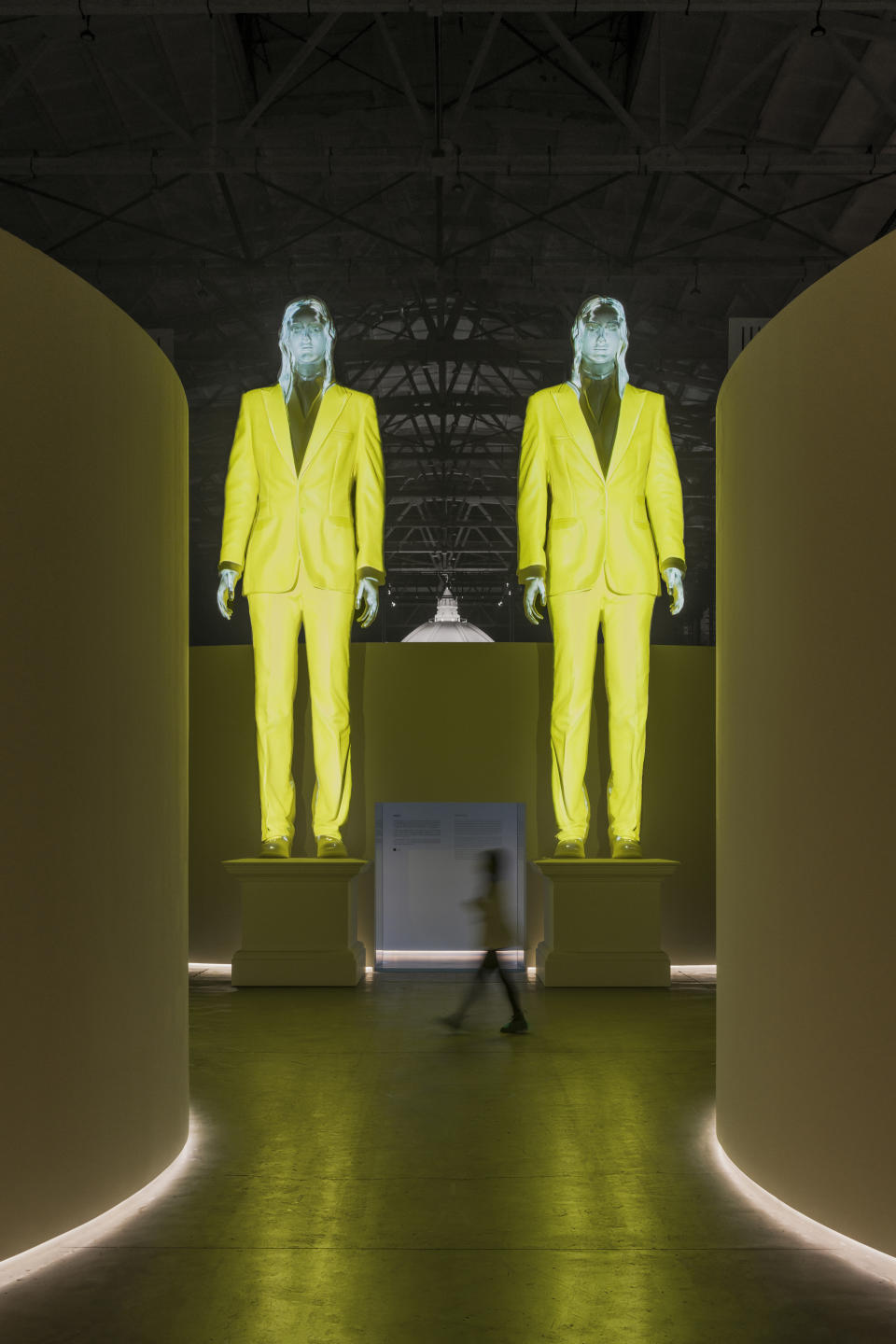
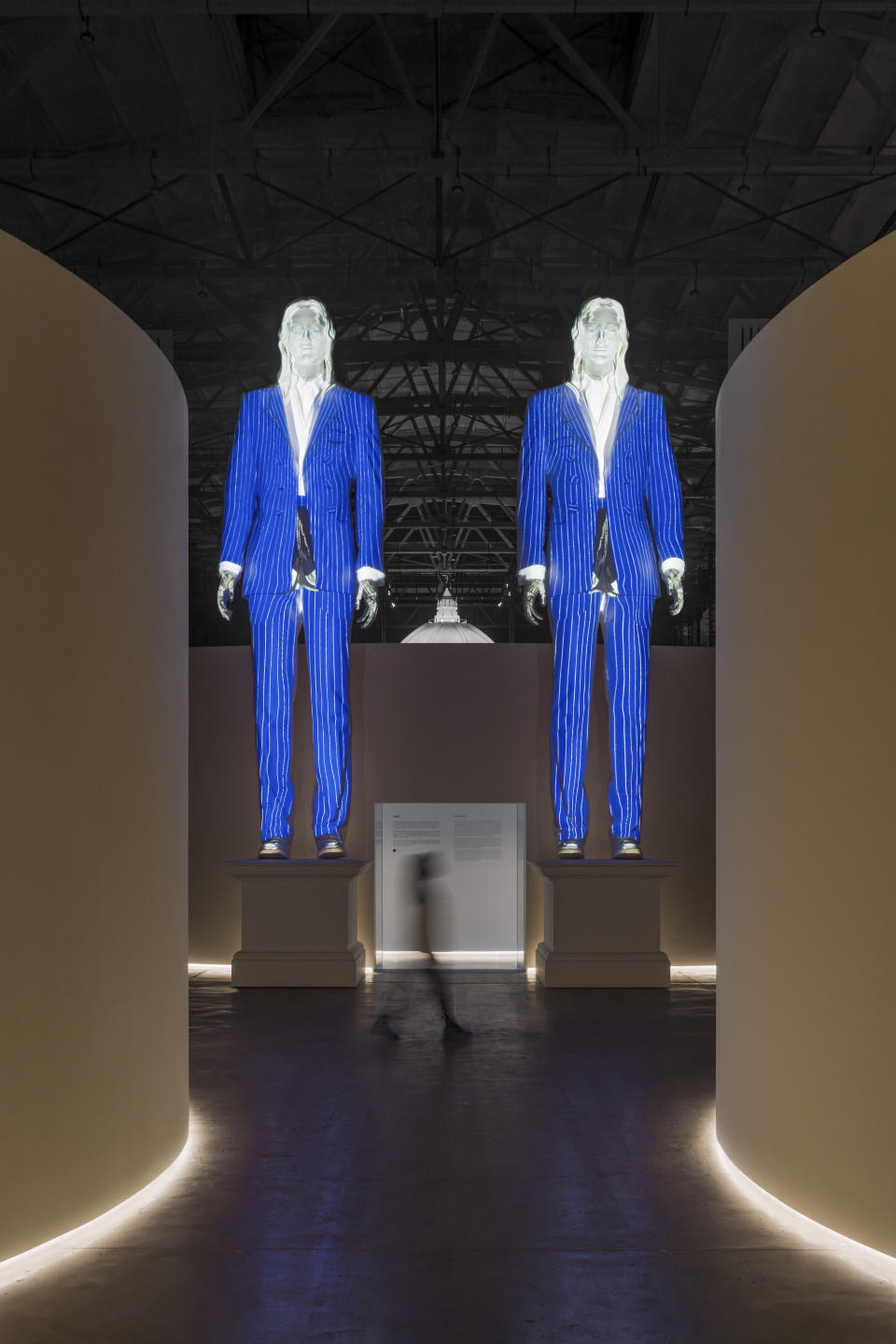
The towering figures, or the “Two,” act as a blank canvas as looping images of high-impact colorways and prints sourced from Gucci’s men’s and women’s suits are projected onto the manniquins.
“The monumental statues represent at the same time, men and women. This is a part of the vision that Gucci has always had,” explained Frisa.
The androgynous gatekeepers not only guard the archival handbags in the next room, they will likely become the center of social media attention for the duration of the show.
The next room is the “Archivio,” a maze-like circular space filled with baby blue cabinets, drawers, and mirrored ceilings that echo the Gucci Archive‘s interior design in Florence. Variations of the Bamboo 1947, the Jackie 1961, the Horsebit 1955, the Gucci Diana, and the Dionysus are prominently featured. Drawers can be readily opened to reveal pages from artisans’ sketchbooks and replicas of vintage ad campaigns.
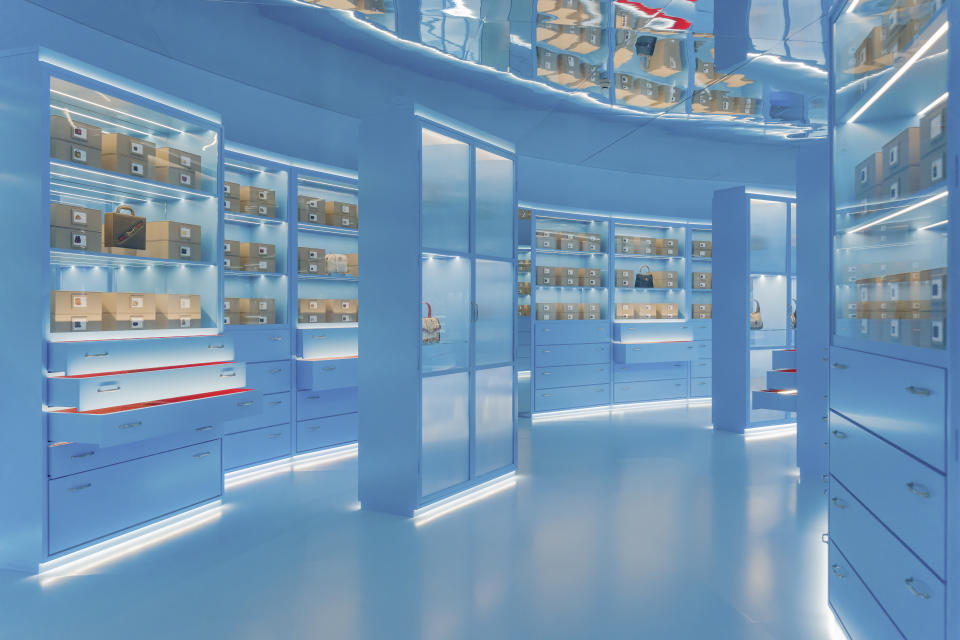
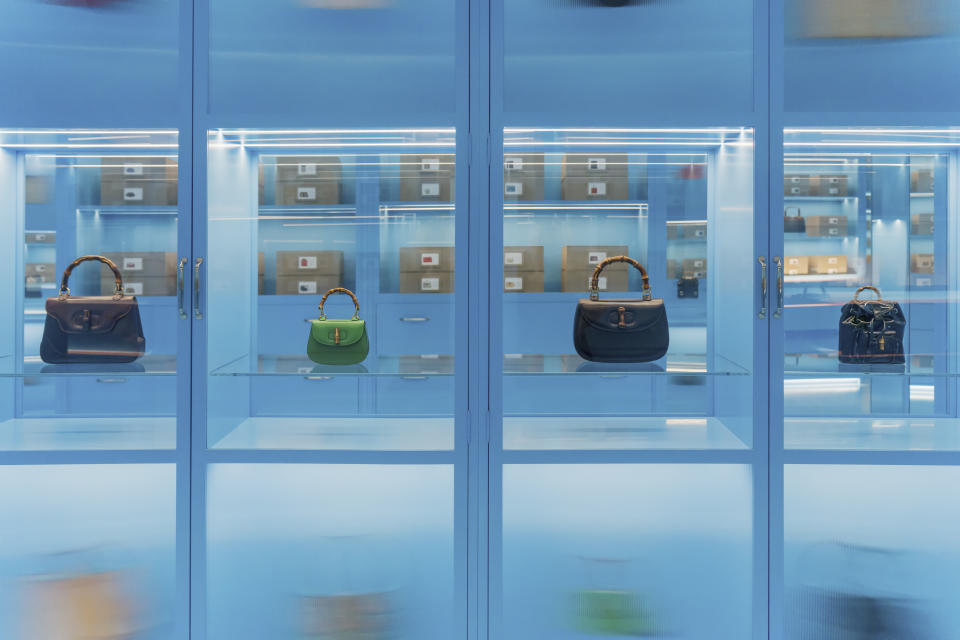
Within “Archivio” sits the sixth exhibition space called “Cabinet of Wonders.” A rotating cabinet of curiosities, a set of accented monolithic cubes set in deep red lacquer features moving compartments that reveal a series of standout garments and props, including a Tom Ford-era electric guitar, Alessandro Michele-era Mickey Mouse clutch and heart-shaped clutch, as well as a Frida Giannini-era golden evening gown.
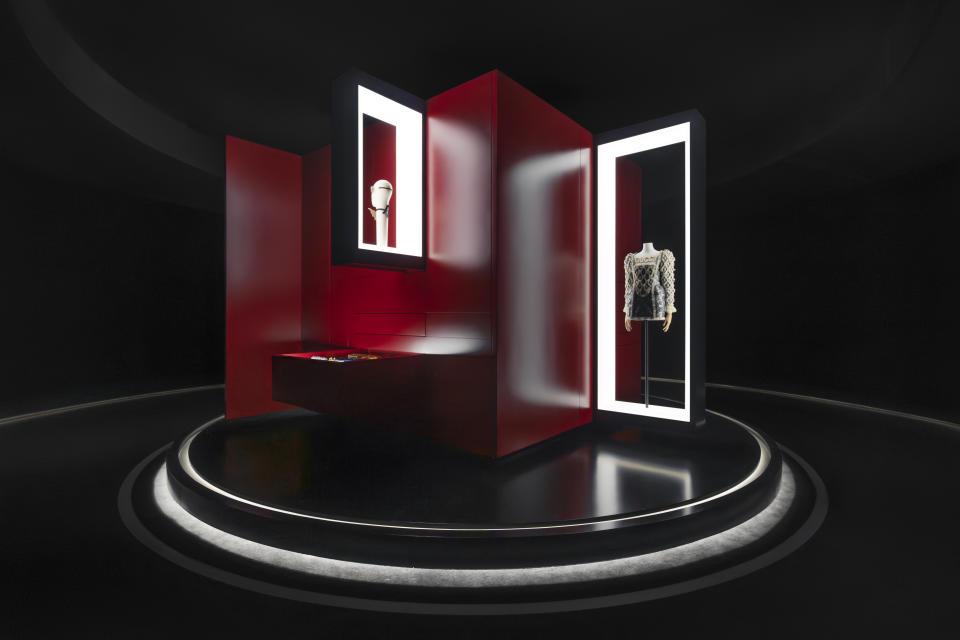
Acting as a pre-conclusion for the show, a parade of 32 runway looks displayed on moving mannequins on top of a conveyor belt complete the set-up for “Carousel,” the second-to-last section.
Filmed over by calligraphy-like drawings from Chinese artists including Victo Ngai, Vikki Zhang, Li Jianmei, and Currynew, “Carousel” neatly ties together designs that span eras while adding a local touch.
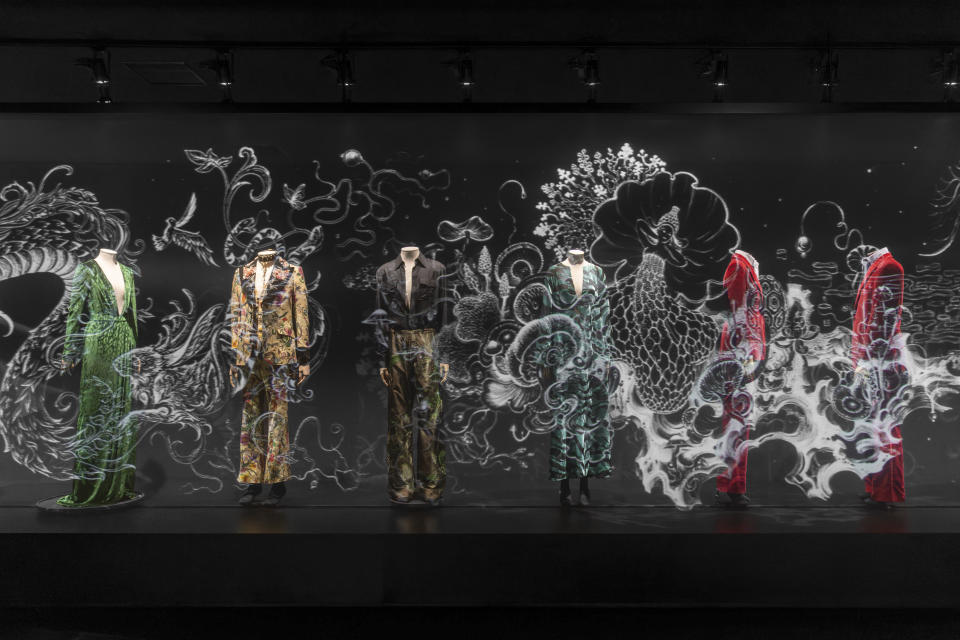
“Each look marked a special moment for the brand, and if you look closely, they are also creating a great dialogue with each other,” said Frisa.
Iconic looks on the mini runway include Tom Ford’s ruby-colored suit, worn and reworn by Gwyneth Paltrow; Alessandro Michele’s floral take on that suit, and Frida Giannini’s chain-embroidered flapper dress.
“All these different visions from different creative directors brought to life different kind of materials that keeps the archive alive,” Frisa added. “In this way, the history of Gucci and the heritage of the brand is continuously reactivated.”
The show culminates in “Duomo,” which features two reproductions of Santa Maria del Fiore, the historical landmark dome in Florence. With one upright and another inverted, the mirroring domes defy gravity and create a dreamlike spectacle that pays homage to the brand’s spiritual and aesthetic home.
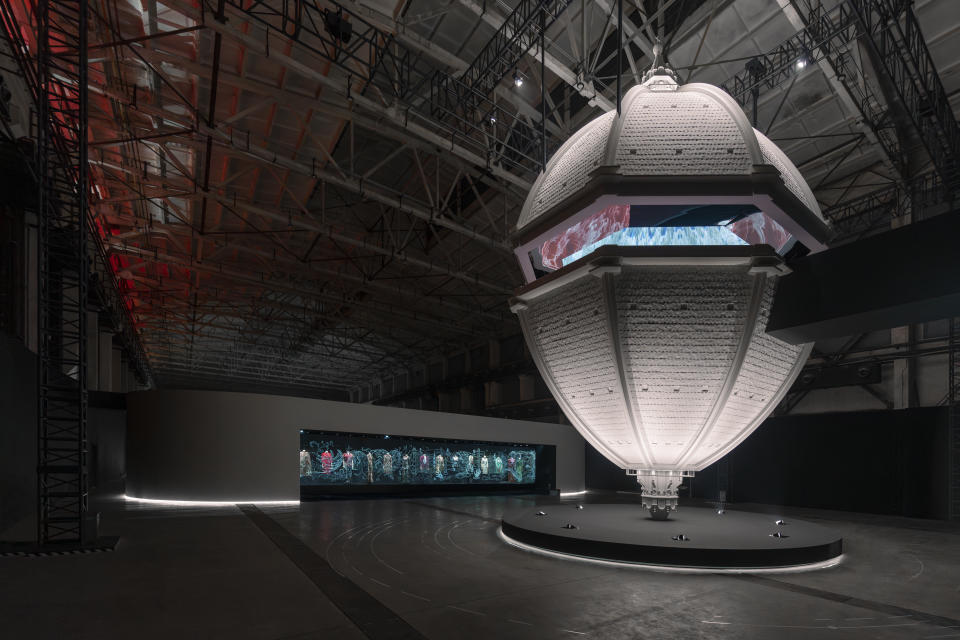
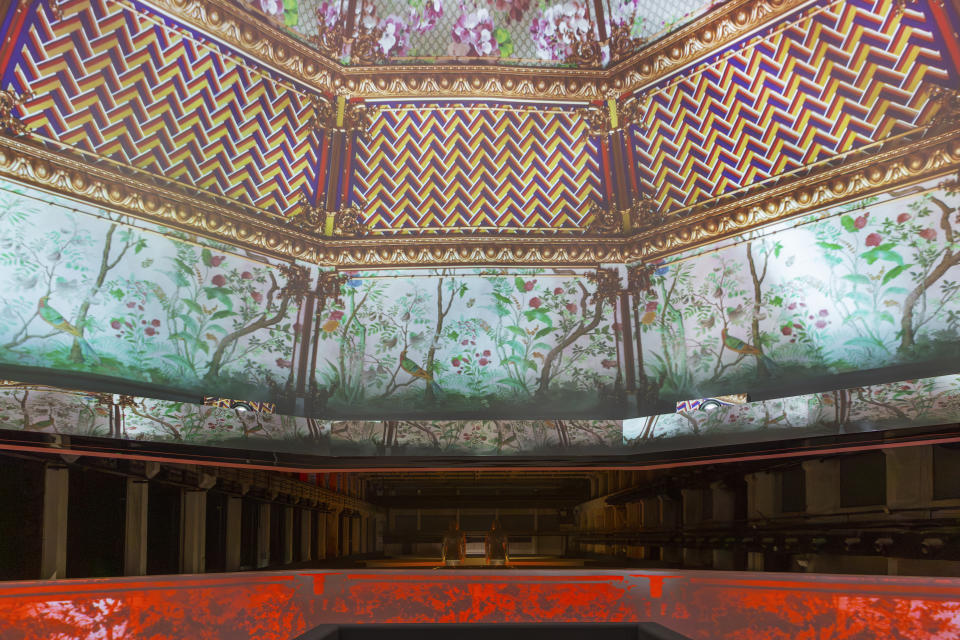
Guests are also invited to enter the dome via a hidden staircase to enjoy an immersive light show featuring Gucci’s most famous prints and gain a bird’s-eye view of the exhibition.
“By bringing the visitors to the dome conceived by Filippo Brunelleschi, one of the greatest architects during the Renaissance, the exhibition ends on a high note,” said Frisa.
Frisa hopes visitors will walk away from the show not only fully immersed, ready to shop for the brand’s latest Bamboo bag, but also understand how fashion reflects our state of mind and the zeitgeist.
“Fashion is the only system that can renovate itself by looking at the past, and Gucci is the perfect example of this capability,” Frisa concluded.
Best of WWD

